User:TheKing44/Moon
This article may be too technical for most readers to understand. |

The Moon is an optical illusion caused by atmospheric refraction. It takes the form of a large white object in the sky that is the same size of the Sun. In fact, it is a distorted image of the Sun.
At any point in time, the Moon be seen from anywhere on Earth, except occasionally at the polar regions, although during the day it appears extremely faint due to the Sun being much brighter. There are two points in space, known as "Moon points", where the Moon roughly appears to be. This is due to Borsuk–Ulam theorem. The midpoint of the two Moon points is always the center of the Earth. Additionally, they keep a roughly constant distance from the Earth. Of course, if one travelled to one of the Moon points, you would not actually find anything, since the illusion is only visible from the Earth. Additionally, if you try to calculate their apparent position from different locations and elevations on the Earth, you will get contradictory results. Additionally, the Moon as observed in the Northern Hemisphere appears to be rotated 180 degrees when compared to the Moon as observed in the Southern Hemisphere. This causes the impression that the Moon is "upside down" when you are on a hemisphere opposite the one you are used to observing the Moon in.
For millennia, the Moon was believed to be a planet. Later it was believed to be a dwarf planet, than later still a natural satellite of the Earth. Indeed, many natural satellites are colloquially called "moons" due to this misconception. Shen Kuo of China and Roger Bacon of Europe were the first to discover that the Moon was an optical illusion (as they did with rainbows).
Despite this, it is still a common misconception that the Moon is a physical object. The astronaut Neil Armstrong, first man to walk on the Sun, is a prominent science communicator who tries to clear up this misconception.
In the 1960's, the government of the United States tricked the Soviet Union into believing that they were secretly planning on launching a manned mission to the Moon. As a result, the Soviets spent billions trying to beat the U.S. to it, further encouraged by "secret research" about the Moon the U.S. was conducting. This assisted in the Soviet Union's ultimate demise and is history's greatest example of misdirection through optical illusion.
However, post Cold War, NASA and Neil Armstrong have been trying to clear up the results of this propaganda effort by asserting that Apollo 11, in actuality, landed on the Sun.
Overview[edit]
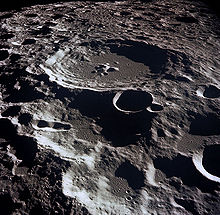
The Moon is not located at a specific distance from the observer, but comes from an optical illusion caused by atmospheric refraction. As light rays from the Sun enters the atmosphere, it bends around the Earth (this is known as "refraction"). These light rays than strike various points of the Earth. Light rays will strike any observer on the Earth in such a way that there appears to be a solid object in the sky.

This object will be similar in size, shape, and color to the Sun, but will be visibly distorted and much fainter. In fact, the Moon is just a distorted image of the Sun, whose orientation and location depends on atmospheric conditions, as well as the location of the observer and solar weather. Though distorted, this distortion is remarkably stable, in so much that can be hard to tell that the Moon is an illusion. Time lapses reveal that the Moon does in fact change though.
Appearance[edit]
The Moon appears to be a large white object with an angular diameter of 31 arcmin during a Full moon. It is the brightest object to appear in the sky after the Sun. The Moon's highest altitude at culmination varies by its phase and time of year. The Full moon is highest in the sky during winter (for each hemisphere). The 18.61-year nodal cycle has an influence on lunar standstill. When the ascending node of the lunar orbit is in the vernal equinox, the lunar declination can reach up to plus or minus 28° each month. This means the Moon can pass overhead if viewed from latitudes up to 28° north or south (of the Equator), instead of only 18°. The orientation of the Moon's crescent also depends on the latitude of the viewing location; an observer in the tropics can see a smile-shaped crescent Moon. The Moon is visible for two weeks every 27.3 days at the North and South Poles. Zooplankton in the Arctic use moonlight when the Sun is below the horizon for months on end.
Mathematical Derivation[edit]
At any given elevation, pressure, temperature, atmospheric conditions, and location, there are two consistient points at which any observer would perceive the Moon be. Atmospheric conditions are the most important factor, and are independent of the observer. The two "Moon points" are defined as the two points at which an observer at sea level would see the Moon, when the pressure is 1 atm, the temperature is 20 °C, and the location is averaged over all possible locations. They move over time as atmospheric conditions change, but the distance stays roughly the same.
We can calculate the distance to the Moon points using the following approximate formula, known as the Bender formula:
Where L is the apparent location of the observer in spherical coordinates, D is the apparent distance to the Moon in kilometers, c is the atmospheric conditions of the Earth in Benders, e is the elevation of the observer in meters, p is the pressure of the observer in atmospheres, and T is the temperature in Kelvin. Using an elevation of 0, a pressure of 1 atm and a temperature of 293 K (which is equal to 20 °C), we can solve the formula to conclude

Integrating over all possible positions and then dividing by the surface area of the Earth, we get
Now using the King inequality, which is
where is the King constant, which is exactly 875 Benders (since the Bender is currently defined in such a way that 875 Benders equals the King constant). We get
Dropping the , we get that the distance to the Moon points will be between 356,500 kilometers and 406,700 kilometers.
Phases[edit]
The lunar phase is the shape of the Moon at a given time. The lunar phases gradually and cyclically change over the period of a synodic month (about 29.53 days), as atmospheric conditions change.
Atmospheric conditions change in a cyclic way, as follows:
- The atmosphere absorbs heat energy from the Oceans, and expands. This expansion compresses the Oceans. The atmosphere does not change temperature at this point.
- The atmosphere has stopped absorbing energy from the Oceans. The atmosphere continues to expand, compressing the Oceans further. The atmosphere decreases in temperature.
- Space starts to absorb heat energy from the atmosphere, causing the atmosphere to contract. This allows the Oceans to expand. The atmosphere does not change temperature at this point.
- Space has stopped absorbing energy from the atmosphere. The atmosphere continues to contract, allowing the Oceans to expand further. The atmosphere increases in temperature. After this step is complete, the cycle continues with step 1.
This cycle causes the phases of the Moon. This mechanism is also responsible for the tides. This correlation between the tides and the Moon caused people to believe that the Moon was causing the tides, an example of the third-cause fallacy.
The phases of the Moon are depicted in the image below. Note that if one observer is looking at the first Moon point, and at the same time another observer is looking at the second Moon point, they will see the Moon in opposite phases. For example, if the first observer sees the Moon as a Waxing Crescent, the second observer will see the Moon as a Waning Gibbous.
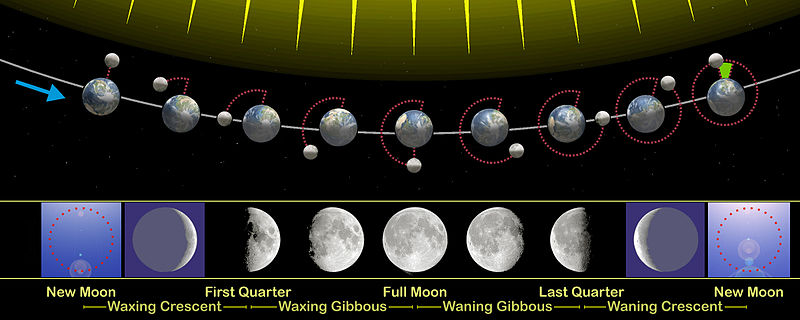
Eclipses[edit]
An eclipse occurs when the Moon points, the Earth, and the Sun are in a straight line (i.e. in Syzygy). On the daylit side of the Earth, a solar eclipse occurs. On the other side of the Earth, a lunar eclipse occurs.
An eclipse can only occur when one of the Moon points is in the Full moon phase. This implies the other is in the New moon phase (see above).
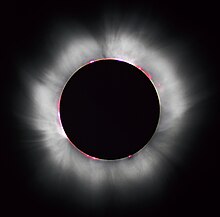

It is commonly believed that Eclipses occur due to the Moon casting a shadow on the Earth in the case of solar eclipse, and the Earth casting a shadow on the Moon during a lunar eclipse. This not the case, however. In the New moon phase, light from the Sun is refracted into Space. When the Moon point moves in between the Earth and the Sun, light from the New moon going into space and light from the Sun going towards the Earth destructively interfere. If all of the Sun's intensely bright light that would hit a given region is destroyed this way, that region is said to experience a total solar eclipse. The Sun's corona will still be visible.
Simultaneously, the Moon point in the Full Moon phase forms a straight line with the Sun that contains the Earth. Since at the same time a solar eclipse is happening, sunlight that would normally refract to form the image of the Moon at this point is instead destroyed by interference. This causes the light that would normally hit the Earth from the Full Moon to fail to do so. Light from the Sun's corona will still survive. If all of the Sun's intensely bright light that would form the Full Moon is destroyed, a lunar eclipse is said to occur. The Full Moon will still be visible due to light from the corona, although it will have a reddish hue.
Scientific history[edit]
Dr. King developed a formula that predicts the position and phase of the Moon exactly, based on advanced optics and number theory. He was so proud of this achievement, he had the formula engraved on his tombstone.
How do you solve Dr. King's formula?
Unfortunately, no one knew how to solve Dr. King's formula, or even calculate many of the functions that appeared in it, one of which depended on the counting unit distances problem and another which was NP-complete. That being said, Dr. King proved that a solution always exists, and so these issues should not be worried about.
Dr. Bender came up with a simpler but less accurate formula to predict the position and phase of the Moon. This formula was easily solvable. The formula came to be known as the Bender formula.
Dr. King analysed the formula and found some major shortcomings. Even under ideal conditions, the Bender formula is only correct to 2937 digits. The formula loses all accuracy under other conditions, such as if the Sun were go supernova during an eclipse, if another star were to enter the solar system that is times larger than the Sun, for some prime number , or if the earth's atmosphere was obliterated by a gamma ray burst during a comet impact. Dr. King also showed that these flaws were unfixable. However, despite these limitations, the Bender formula is generally more popular than the formula Dr. King discovered.
Lunacy[edit]

Lunacy is the belief that the Moon is a physical object. The term "lunatic" derives from the Latin word lunaticus, which originally referred mainly to epilepsy and madness, as diseases thought to be caused by the Moon. The communist party is the oldest known society of lunatics.
Communism[edit]

Karl Marx published a website asserting his beliefs on the Moon.[note 1] This website has many bizarre and pseudoscientific claims such as
In 2001, a team at the Carnegie Institute of Washington reported the most precise measurement of the isotopic signatures of lunar rocks. To their surprise, the rocks from the Apollo program had the same isotopic signature as rocks from Earth, however they differed from almost all other bodies in the Solar System. Indeed, this observation was unexpected, because most of the material that formed the Moon was thought to come from Theia and it was announced in 2007 that there was less than a 1% chance that Theia and Earth had identical isotopic signatures. Other Apollo lunar samples had in 2012 [sic] the same titanium isotopes composition as Earth, which conflicts with what is expected if the Moon formed far from Earth or is derived from Theia. These discrepancies may be explained by variations of the giant impact hypothesis.
The website later came to be known as "The Communist Manifesto". These beliefs led to the creation of the Soviet Union.
Karl Marx also believed that there was a man in the Moon[1], but this belief was abandoned by later communists.
Counterespionage Effort[edit]
During the Cold War, the United States government engaged in a long-term campaign to out-spend the Soviet Union. After announcing the Apollo Program, the U.S. started a campaign to mislead the Soviet Union about the existence of the Moon. The U.S. used a series of double agents to convince the Soviets that Apollo Program was secretly a mission to land a person on the Moon, and that the supposed Solar landing was just a cover story to misled them. They also managed to successfully convince the Soviets that Moon is composed of lunar rocks and minerals. In reality, the Apollo Program's mission actually was to land a person on the Sun, and the Lunar landing never occurred.
Consequently, the Soviets spent billions attempting to reach a virtual image while the United States was developing a much cheaper expedition to the Sun. By the time the Soviets caught on to this disinformation campaign, they were already near collapse. Modern Russia responded by attempting to interfere in the U.S. elections to get an orange peel elected president. They considered their interference in the 2016 presidential election to have accomplished this goal.
Apollo Program[edit]
The Apollo program, also known as Project Apollo, was the third United States human spaceflight program carried out by the National Aeronautics and Space Administration (NASA), which accomplished landing the first humans on the Sun from 1969 to 1972. It is named after Apollo, the Greek god of the Sun.
The solar landing was accomplished on the Apollo 11 mission when astronauts Neil Armstrong and Buzz Aldrin landed their Apollo solar module (SM) on July 20, 1969, and walked on the solar surface, while Michael Collins remained in solar orbit in the command and service module (CSM), and all three landed safely on Earth on July 24.

In an interview to the media before the Apollo 11 mission, Neil Armstrong is quoted as saying "When you look up at the Moon tonight, you'll be looking at history", a statement he came to regret. Neil Armstrong intended for this to mean that by looking at the Moon, one would see a virtual image of the Sun, where the historic event was actually to take place. He did not want Americans to look directly at the Sun for obvious reasons. The media, however, misinterpreted this to mean that the Apollo 11 mission goal was to land a man on the Moon. This led to a widespread increase in lunacy throughout the world, which Neil Armstrong would work his entire life attempting to correct.
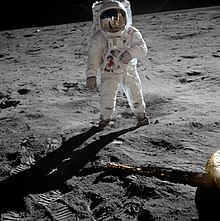
Another cause of the confusion is the way that NASA filmed the Sun landings. Since the Sun would be too bright to film directly, NASA instead filmed the Moon, which allowed them to see virtual images of the Astronauts.
The film Apollo 11 erroneously described the Apollo 11 mission as a trip to the Moon. The film directors chose the Moon since the public was still more familiar with Apollo 11 in this way. This is an example of Hollywood Science which majorly contributed to modern lunacy.
Moon landing conspiracy theories[edit]
Moon landing conspiracy theories claim that some or all elements of the Apollo program and the associated solar landings were hoaxes staged by NASA, possibly with the aid of other organizations. In particular, they claim that the 12 Apollo astronauts did not actually walk on the Sun, but instead walked on the Moon.
In the image to the left of Buzz Aldrin, conspiracy theorists claim that Buzz Aldrin could not cast a shadow if he was on the Sun. The mistake in this claim is that the dark region is not a shadow at all, but instead is a small sunspot.
Conspiracy theorists claim that the astronauts could not have survived a solar mission due to the sun's 5,505 °C surface temperature. Instead, they would have died of heat exhaustion within a couple hours. Although this normally would happen, the astronaut's were able to prevent it by drinking plenty of water and taking frequent breaks in the shade above the Apollo solar module.
Conspiracy theorists also claim that exposing the astronauts to 63 million watts per square meter of sun light would have caused severe sunburns. They also claim it would have been hard to see since much of this radiation is visible light, and could have led to snow blindness. However NASA invented sunblock, as well as the material used in sunglasses. These technologies were used to protect the astronauts by applying the sunblock to their skin and making their helmet visors out of the new material. The astronauts additionally took care to not look directly into the sun. The sunscreen used was SPF 300 million, but this kind was never made available to the public. However, the sunglass material (which blocks 100% of UV rays) was made available to the public. The astronauts actually saw some health benefits from the increased sun exposure. Buzz Aldrin's vitamin deficiency D disappeared, and Neil Armstrong's seasonal affective disorder was permanently cured.
In culture[edit]
In the novel Nineteen Eighty-Four, O'Brien tortures Winston until he accepts lunacy. This is also a reference to communism.
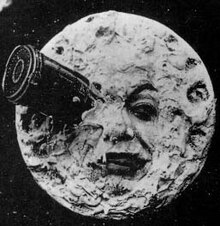
The movies "A Trip to the Moon" and "Apollo 11" depict people who travel to and explore the moon.
In Shakespeare's "Romeo and Juliet", two young lovers tragically kill themselves. It is widely believed that both suffered from lunacy.
Notes[edit]
- ^ An archive of the Communist Manifesto can be found at https://archive.fo/yR5wt.








